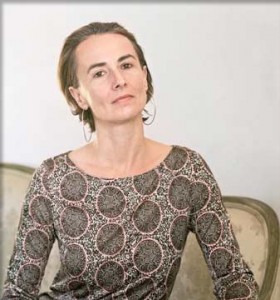Renowned novelist Stacey D’Erasmo will take the FPP Harlem stage next Monday at Shrine (event begins at 6:45 with DJ Lady DM). We talk to her about her visual arts influences and her love of (NY) city life.
 You published first as a critic. What effect did that training have on your first novel? And now? It was actually pretty liberating. For one thing, when I was first writing reviews, primarily for the Village Voice Literary Supplement, I was writing for a very smart, very welcoming and open-minded audience, so I truly felt that I could express myself without reservation. Also, I was writing on deadline, which meant that self-consciousness never had the time to overtake me. I got accustomed to taking risks. The other helpful aspect was that, since I wrote criticism and knew so many amazing critics, I didn’t think of criticism and reviewing as mystical processes conducted by superior and possibly vengeful beings. I just thought reviews were written by smart people who cared passionately about books and usually didn’t make a lot of money. When my own first book was being reviewed, I wasn’t terrified of reviewers, which helped quite a lot.
You published first as a critic. What effect did that training have on your first novel? And now? It was actually pretty liberating. For one thing, when I was first writing reviews, primarily for the Village Voice Literary Supplement, I was writing for a very smart, very welcoming and open-minded audience, so I truly felt that I could express myself without reservation. Also, I was writing on deadline, which meant that self-consciousness never had the time to overtake me. I got accustomed to taking risks. The other helpful aspect was that, since I wrote criticism and knew so many amazing critics, I didn’t think of criticism and reviewing as mystical processes conducted by superior and possibly vengeful beings. I just thought reviews were written by smart people who cared passionately about books and usually didn’t make a lot of money. When my own first book was being reviewed, I wasn’t terrified of reviewers, which helped quite a lot.
You write about music, dance, and art and have collaborated with artists of many disciplines. Can you tell us about a collaboration that has changed your writing or the way you think about writing? I have frequently collaborated with the photographer Elizabeth Heyert, whose work I admire tremendously. Her projects tend to be portraiture of a particularly innovative nature and the keenness of her eye and the sensitivity of her aesthetic have influenced me on every level–the images themselves have found their way into my work, but, more profoundly, Elizabeth’s astonishing way of looking has taught me much about how to see emotion in gesture, color, and light. For Elizabeth, the subject of one of her portraits is never a passive object but a kind of collaborator, another human being who always retains an essential mystery and agency. I try to honor that same degree of unknowability in my characters.
Have you seen or heard a work of art recently that has influenced you? Oh, sure–all the time. I saw the film Pina twice last year, and the density and singularity of that choreography still haunts me. I was also much taken by the way Bausch worked with weight, because aspects of weight infuse the novel I’ve just finished, Wonderland. More recently, I went to see Ann Hamilton’s “The Event of a Thread,” and I’d love to find a way to render in prose the delirious/faintly post-apocalyptic quality of that installation.
NYC has been home for a while for you; what aspects of population density do you embrace and which do you chafe at? I really am a city girl, because, honestly, I embrace nearly all of the aspects. The only thing I much hate is when people stand by the subway doors and won’t move when other people are getting out. Why must people do that?
Where in the city (or beyond) do you feel most like a “we”? Well, ironically given the above, on the subway. I never get tired of looking at all the people on the subway and knowing that I’m among them, another face in the crowd. But then, I was also in New York during September 11th, the blackout of 2003, and, just recently, Hurricane Sandy. At those moments when everything grinds to a halt and you walk outside to see everyone else walking around, suspended in time, it feels more than ever like we’re in it, in this city, together.
